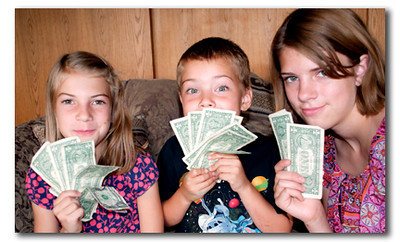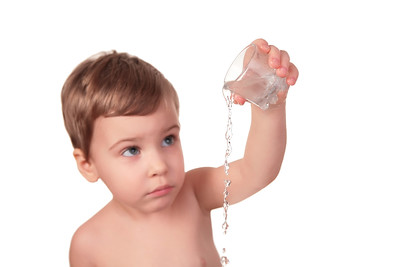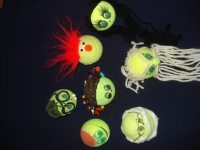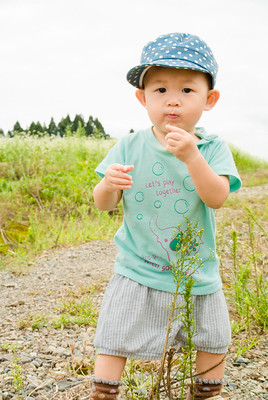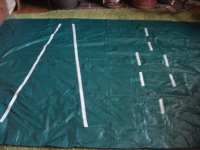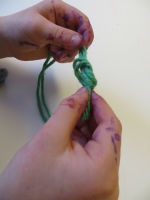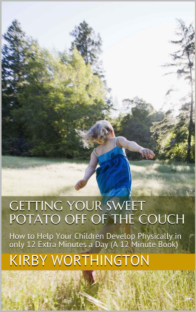Find many creative ideas to get children leaping ahead in their physical development, all while done with things found at home. This is the time to take a minute to watch these and strengthen your options while stuck at home. Enjoy!
Building on "Teaching Kids About Money, Part 1" and "Part 2," the following practical ideas can be considered:
Money games for pre-schoolers to help them learn the worth of money:
- Take file cards and trace around coins. The child can try to fit coins into the spots. Make cards in which the value is explained. One traced nickel equals five traced pennies, one dime equals two traced nickels, and so on. (This is a tough concepts for youngins, since the dime is smaller than a nickel but worth more.)
Note: children like handling coins. Do so for a short time. Do not do it until they lose interest. And do not do it around littles who put them in their mouths. Older children can play with these cards on a tray or box lid to keep it out of reach of younger siblings.
Children today experience a very different environment to the one their parents grew up in. Back in the day, Mr. Rogers knew what he was doing when he built a time into his program simply for thinking. We need to spend time every day just thinking. Just imagining.
As a parent, remember to carve out time for your child to have a quiet, slower time to stop, look, and listen. A time to be outside and observe.
For further reading see:
Pouring can wire the brain for math -- quantity, more/less -- when done regularly. And it can be done with lots of different things.
For starters, during bath time add big and little cups. How many little cups fit into the big cup? Bring some measuring spoons along. How many measuring spoons fill a very small cup? (If you're using something small to pour into a big container, this may get discouraging.) Add bubbles to the bath for variety. (Word of warning: girls may get irritated skin in sensitive areas if spending too long in bubbles.)
Pouring is also good for getting finger, hand, and arm muscles firing. Even better when you add stirring (pretending to cook) into the mix. These are so helpful with everyday tasks.
Here are two learning games that can be done while going about normal everyday tasks that will involve children age two or older in growing developmentally all while getting things done!
ORDER GAME
Materials:
As mentioned previously, children today are learning to type but their hands aren't strong enough to write or do other tasks like being able to eat without spilling on themselves which is a skill that requires hand strength and coordination. People want and need to write legibly and quickly. Arts and crafts, the playing of musical instruments, cooking, measuring....all parts of life require finger strength.
Here is a list of some ways to build finger strength:
- climbing trees or jungle gyms
- folding clothes (make a matching game out of the socks)
- crawl through toy tunnels or cardboard box tunnels
- pretend to be animals and crawl around
- sweep with a child-size broom
- wash the car (or make a car wash tunnel with a garbage bag cut into strips - this can also be seaweed that they can crabwalk through on the ocean floor)
- cooking! stir, knead, cut, roll
- play with playdough or clay (which is even better for strengthening)
- give the baby doll a bath or handwash the doll clothes - wring them dry and hang them out on the line with clothespins
- sewing cards that progress to learning stitches, sewing on a button, and more
- ball puppets (see below)
How to make a ball puppet:
Travelling with children can be a special time, even on a road trip! The kids have the potential to triple their vocabulary on a week-long car trip if that's what is chosen to work on. Relationships among family members can improve with interactive car games. Whether infant, toddler, or early elementary, littles can have fun and leap ahead in cognitive development and fine motor skills while en route to your holiday destination.
While technology is a very handy tool to have when travelling, make sure your children are not on their devices the whole travel time. Pack a backpack/travel bag per child that they may fill with their travel treasures. Elementary age children can usually make independent choices on what to leave and what is important to bring. This may include dolls (with add-ins of ribbons, pieces of fabric, etc.) that would be useful for making up stories so be sure to include several that can interact with each other. Comic books, graphic novels, magazines, coloring books, and educational workbooks are all lightweight for easier transportation. Crayons are recommended over markers for use in the car but be sure to keep them in a baggie in case there is weather hot enough to melt them.
A separate family trip bag can be filled with toys that are never seen except for on a trip. These toys might be:
1. Put pieces of masking tape (approximately the length of the child's foot) : one piece for hopping and two side-by-side pieces for jumping along a path. Wherever you put the two pieces, direct your child to "Jump!" and when they get to the single piece of tape remind them to "Hop."
This course can be as long or short as you like, indoor or outdoor, from the kitchen table to the bathroom to brush teeth after a meal, etc. This activity is growing muscles in your child's body, teaching the ability to balance (especially when hopping), and learning to follow directions is a benefit as well.
If you’ve been following our blog posts, you will have seen the last one on the topic of pretending. It was about when pretending might start in your wee ones, why, and some implications to consider. In this post, we’d like to list out some practical ways to increase the development of your child’s imagination. We will give concrete ideas and ways to play together.
First, though, a reminder: when your wee ones start to develop imagination, be aware that little brains work differently than adult brains. (Children are not simply like adults, but small; they are different.) Little minds do not have the experiences, memories, words, or even wiring to imagine what adults find easy to imagine. This one observation has at least two practical implications: One, when helping your child imagine something, it is helpful to engage and develop all of their senses as well as all the words that go with the senses. Two, rather than simply asking the child to imagine something, many times it takes the adult doing something the first time and giving words for it, then interacting with the child in an imaginative state.
One of our jobs is to help our children simply notice the sights, sounds, feelings, etc. that we take for granted. Pointing these out will help develop the various parts of their brain (e.g. the visual cortex). We also help the child interpret what they are seeing and help them to learn the words to describe these things. As they become increasingly aware of the world around, they begin to develop something very helpful in this world: “artist’s eyes”.
 Parents of preschoolers are tired people. Caring for little ones is exhausting work. We have the best intentions of providing enriching activities for our kids, but when exhaustion sets in, good intentions go out the window. To help you plan for those times when you need something your child can do while you are lying down or sitting, here's a list of 20 activities.
Parents of preschoolers are tired people. Caring for little ones is exhausting work. We have the best intentions of providing enriching activities for our kids, but when exhaustion sets in, good intentions go out the window. To help you plan for those times when you need something your child can do while you are lying down or sitting, here's a list of 20 activities.
- Finger paint in shaving cream spread on a cookie sheet.
- Play with play dough.
- Read. If you're reading a well-known book, try changing some of the words or sentences and let your child have fun catching your "mistakes."
- Play Chutes and Ladders or Candyland.
- Put on music and let your child dance. Try giving her a bean bag and challenge her to dance with the beanbag on her head, between her knees, or on her elbow.
- Play "red light, green light."
- Play a following directions game. Give your child silly things to do.
- Put out two or three items on a plate, then cover them up and see if your child can remember what he saw. Let him do the same for you.
- Throw a sheet over a card table to make a fort. Let your child take toys inside.
- Put a little tub of water on the kitchen floor. Gather up a bunch of objects and let your child test if they sink or float.
- String big beads on shoelaces.
When my oldest daughter was 15 months old, her dad built a sandbox. I (Kirby) knew it was going to be perfect! I could hang clothes out to dry while my toddler blissfully discovered pouring and measuring and building and dumping. Montessori had come to my house!
I gathered up my basket of wet clothes, led my little girl over to the new sandbox, and headed for the clothesline. But she just stood there, staring at the sand and looking puzzled. Then it hit me—she didn't know how to play with sand. So I abandoned my laundry and we spent time making mountains together and filling up her dump truck, pouring water onto the sand, and digging holes. After that, she knew what to do, and she knew how much fun it could be.
It's not just kids who haven't learned how to play with sand. Lots of parents don't know what to do with a sandbox either. So here's a list of activities you can do with your pre-schooler in the sand. All of these games build cognitive and physical skills too.
If you're looking for a versatile toy with tremendous developmental benefits, a simple length of string, rope, or yarn is the way to go. Here are some games you can play with that string that address various areas of a child's development. Many of these can be played anywhere! Keep yarn or string in your purse or pocket to pull out when your little one is getting bored and needs something fun and challenging to do.
Balance and Coordination String, yarn, or rope makes a perfect balance beam. Stretch the string out on the floor, and show your child how to walk on it, putting one foot in front of the other. Your child can do lots of fun things on a balance beam:
- Walk on a curvy or zigzag line
- Balance on one foot on the string
- Do an arabesque (or scale)
- Jump zigzags back and forth across the string
- Hop on one foot either on the balance beam or from side to side
- Walk backwards
- Do forward rolls
- Walk on tiptoe on the beam
For more ideas, see this post.
"My son (2.5) is finally into imaginative play. However, the characters aren't always nice to each other. They say things like "you're not my friend". Sometimes they are really bad and get put into the corner. Do I intervene when the characters are being mean and saying things I wouldn't let my son say?"
Sometimes our sweet babies come out with words and behaviors that we haven't taught them. It can be upsetting, and we wonder, "Do I need to nip this in the bud? Or should play be correction-free territory?"
Preschoolers like to "try on" words and actions that they have observed—whether from siblings, preschool, the playground, or tv. Imaginative play can be a safe place to do this experimentation. It doesn't mean they've internalized the behaviors, or that they'll start talking like that all the time.
Colors are one of the first things that parents think about teaching their children. Teaching your preschooler colors can be a lot of fun.
You should wait to introduce colors until your child has a solid vocabulary of nouns. A preschooler's brain is wired to learn the names of objects before learning to describe those objects. Kids have what is called the "language explosion" between 18 and 24 months of age, during which they will be learning lots and lots of nouns. Work with their brains during this time by naming everything, and by not confusing things by adding adjectives.
After about the age of two, your child may be getting ready to learn colors. The best way to kick off this process is by having a "red day." (Really, it can be any color you want.) Pick a color, like red, and focus on it. Have everyone wear red. Pick red foods to eat. Pull out red blocks or red toys. Finger paint with red paint. Put up red streamers and balloons and hang red tissue paper over the window. Get as much red in your day as you can. Every time you see something red, point it out.

